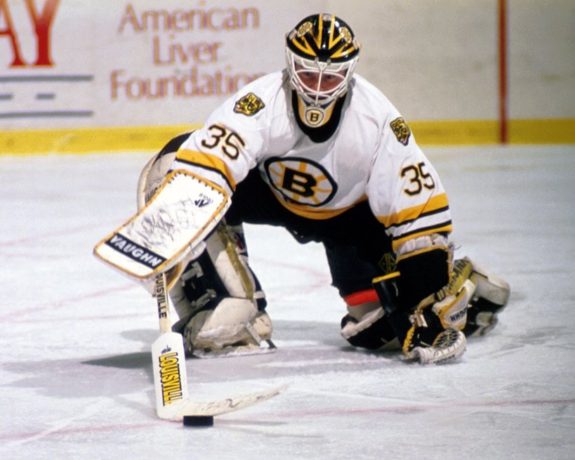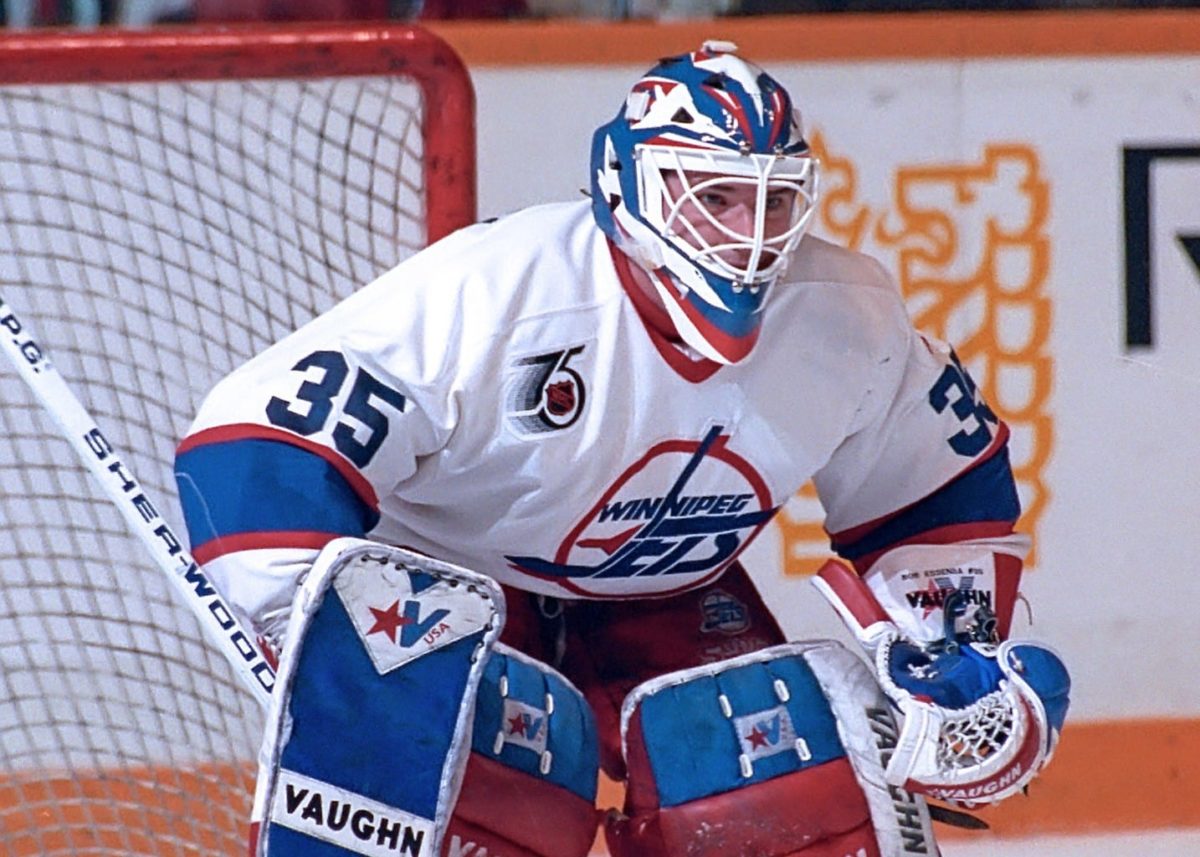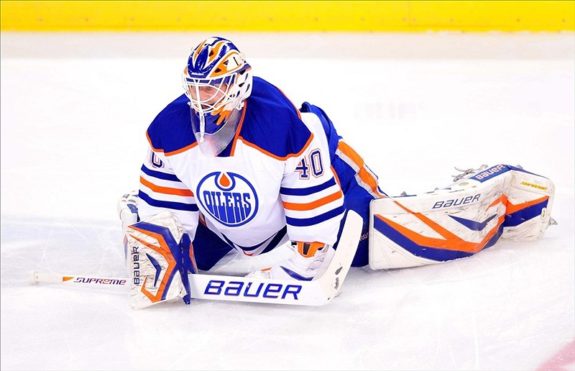The importance of having a high-quality goaltender in the NHL cannot be understated. Furthermore, having a “hot” goaltender can be the difference between bowing out in the first round of the playoffs and making a Stanley Cup run.
However, when a team’s superstar goalie is hurt, not playing well, or needs a rest, it is crucial to have a capable backup at the ready. Not only do successful teams have one great netminder, they often have two. Throughout their history, the Edmonton Oilers have featured several outstanding backup goaltenders. Let’s take a look at the Oilers’ best backup goaltender from each decade.
The 1980s: Andy Moog
Andy Moog is by far the Oilers’ most iconic backup goaltender. Drafted by the Oilers in the seventh round, 132nd overall, of the 1980 NHL Entry Draft, Moog would go on to become one of the Oilers’ most valuable late-round draft picks of all time.
During the 1980-81 season, Moog spent most of his time playing in the minor leagues. Late in the season, however, he got his first opportunity in the NHL due to injuries to Oilers’ goaltenders Ron Low and Eddie Mio. Moog shined for the Oilers, leading them to a sweep of the Montreal Canadiens in the first round of the playoffs.
It wasn’t until the 1982-83 season that Moog made the Oilers’ roster full time, playing behind goaltender Grant Fuhr. Moog won the starting job again late in the season and ultimately led the Oilers to their first Stanley Cup Final appearance against the New York Islanders.
Although they did not win the Stanley Cup, the Oilers bounced back the following season and made the Stanley Cup Final again. However, this time Fuhr started in net for the majority of the playoffs, but he went down with an injury in Game 3 of the Final, handing the reigns back to Moog. With Moog in net, the Oilers defeated the Islanders 4-1, clinching their first Stanley Cup in franchise history. Moog played as a backup to Fuhr for several seasons but was traded to the Boston Bruins at the trade deadline of the 1987-88 season.

Moog played in Boston for six seasons, followed by three seasons in Dallas, and one season in Montreal. Moog’s 18-season NHL career boasts a multitude of accolades, including three Stanley Cups as a member of the Oilers. Among goaltenders who have won at least 300 games, Moog ranks eighth all-time in winning percentage, winning 52.17 percent of his 713 games played. Having been in the net for not only their first-ever postseason series win but also their first Stanley Cup Championship, Moog has cemented his name in Oilers’ history.
The 1990s: Bob Essensa
After winning the 1990 Stanley Cup, the 1990s were a bumpy ride for the Oilers. They missed the playoffs for several seasons in the early 1990s but regained some strength in the late 1990s, albeit not to the point of being Stanley Cup contenders. After what had also been a roller coaster of a ride for Bob Essensa, he found himself playing for the Oilers in 1996-97 after being dealt from the Detroit Red Wings. Prior to this, Essensa was drafted 69th overall in the 1983 NHL Entry Draft by the Winnipeg Jets and spent six seasons with the team.

Essensa had struggled in previous seasons, so landing in Edmonton was the fresh start the former Vezina Trophy finalist needed. In his first two seasons, he was a serviceable backup to Curtis Joseph. In his final season with the Oilers, 1998-99, Essensa split time with Mikhail Shtalenkov and later in the season, backed up Tommy Salo. Essensa played a total of 74 games for the Oilers, finishing with a .904 save percentage (SV%) and a 2.73 goals-against average (GAA). Overall, Essensa’s seasons in Edmonton allowed him to resolidify his reputation as a solid backstop in the NHL.
The 2000s: Jussi Markkanen
You have got to love an underdog story. At the age of 25, Jussi Markkanen was drafted by the Oilers in the fifth round of the 2001 NHL Entry Draft, 133rd overall. In his first two seasons with the Oilers, Markkanen played 36 games at the NHL level, backing up goaltender Tommy Salo.

During the 2003-04 season, Markkanen was traded to the New York Rangers. Markkanen was back in Edmonton just nine months later after being traded back to the Oilers from the Rangers. It was not until the 2005-06 season that Markkanen finally made his mark in Oilers’ history. Despite barely making the playoffs, the Oilers’ found their stride at the right time and made their way to the Stanley Cup Final against the Carolina Hurricanes.
During Game 1 of the Final, starting goaltender Dwayne Roloson was injured in a collision during the third period. Ty Conklin relieved Roloson but played poorly, opening the door for Markkanen. After struggling to make a name for himself for several seasons, Markkanen was given the opportunity of a lifetime in Game 2, a start in the Stanley Cup Final.
Markkanen led the Oilers all the way to a Game 7 and even recorded a shutout in Game 6. Although the Oilers went on to lose to the Hurricanes, Markkanen rose to the occasion and treated Oilers fans to a thrilling Stanley Cup series for the first time in 16 seasons.
The 2010s: Devan Dubnyk
The second decade of the 21st century was overwhelmingly disappointing for the Oilers. The 2010-11 season featured starting goaltender and Stanley Cup champion Nikolai Khabibulin and backup Devan Dubnyk. The Oilers drafted Dubnyk 14th overall in the 2004 NHL Entry Draft. Although most of his time in Edmonton was during the 2010s, Dubnyk got his first opportunity in the NHL during the 2009-10 season when Nikolai Khabibulin’s season got cut short by an injury.
Dubnyk played behind Khabibulin the following season, too, but he made the most of it. Playing in 35 games, Dubnyk recorded 12 wins and a .916 SV%. After impressing the coaching staff, he earned the starting role to begin the 2011-12 season. Unfortunately, Dubnyk struggled early in the season and forfeited the starting role to Khabibulin. Despite a rocky start, Dubnyk played better as the year progressed and ultimately played in 47 games, tallying 20 wins with a .914 SV%.

Fresh off of a two-year, $7 million contract extension, Dubnyk obtained a full-time starter role for the first time during the 2012-13 season. Although the Oilers continued to struggle as a team, Dubnyk played well and finished the season with a .920 SV% and 2.57 GAA. The following season, in what would be his last with the Oilers, Dubnyk could not keep the momentum going. He never regained his form, mustering just a .894 SV% and 3.36 GAA in 32 games, and was traded to the Nashville Predators in exchange for forward Matt Hendricks.
In light of his struggles, Dubnyk may be the goaltender that got away from the Oilers. The season after leaving Edmonton, he was a Vezina Trophy finalist and won the Bill Masterton Memorial Trophy, given to the player who “best exemplifies the qualities of perseverance, sportsmanship, and dedication to hockey.“
Having an elite goaltender is invaluable in the game of hockey. But, at the end of the day, it is a team sport and depth is just as important for a team to make a championship run. The 2020s are upon us and the Oilers will need to establish a talented goaltender tandem to achieve Stanley Cup glory for the first time in 30 seasons.